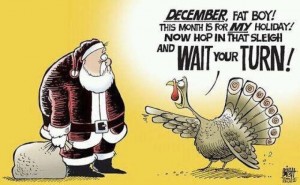If you believe in environmental preservation, Thanksgiving has to be your favorite holiday. No offense to Earth Day, but Thanksgiving is the only day of the year with major holiday cachet that hasn’t been conquered by the profit motive and reduced to a fertility dance of selling, buying and throwing away.
 We don’t wake up to Thanksgiving trees harboring Thanksgiving gifts swathed in Thanksgiving ribbons and wrapping paper on the last Thursday of November. There are no Thanksgiving baskets stuffed with Thanksgiving eggs, jelly beans and marshmallow turkeys all nestled in neon-colored plastic “grass” made from enough petroleum to power a Humvee. There are no Thanksgiving costumes, no Thanksgiving-themed candy bars to be hustled door-to-door. DeBeers diamonds and Hallmark don’t bull-rush the airwaves every November to cajole you into buying a tennis bracelet and a greeting card for your Thanksgiving sweetheart.
We don’t wake up to Thanksgiving trees harboring Thanksgiving gifts swathed in Thanksgiving ribbons and wrapping paper on the last Thursday of November. There are no Thanksgiving baskets stuffed with Thanksgiving eggs, jelly beans and marshmallow turkeys all nestled in neon-colored plastic “grass” made from enough petroleum to power a Humvee. There are no Thanksgiving costumes, no Thanksgiving-themed candy bars to be hustled door-to-door. DeBeers diamonds and Hallmark don’t bull-rush the airwaves every November to cajole you into buying a tennis bracelet and a greeting card for your Thanksgiving sweetheart.
No, Thanksgiving is built around the primal pleasures of a good meal, good company, and gratitude for good fortune. Since there’s only so much money to be made in selling turkeys and cranberry sauce, the chances are pretty good that Thanksgiving will soldier on in the shadow of Christmas and Halloween, less ballyhooed but safe from the ravages of marauding commercialism.
Even though Thanksgiving is pretty environmentally friendly on its own, it also harbors opportunities for the environmentally conscious to help biodiversity by “voting with their dollars,” in the words of John Forti, a nationally known garden historian, herbalist, and museum curator based in CleanSpeak’s home of Portsmouth, N.H. Forti is a mover in the Slow Foods movement, an international effort to re-build the lost bonds between eating and community. One of the fallouts of the modern food economy, he explains, is the loss of genetic diversity in agriculture. When huge populations depend on a narrow range of food sources – one or two breeds of cows for milk, for example – they are vulnerable to disasters like the Irish Potato Famine of 1845, when fungus wiped out the main variety of potato the country’s poor lived on. Over the last 100 years, 75 percent of the genetic diversity in agricultural crops has been lost, according to Unhabitat.com.
“Buying products like heirloom produce and heritage-breed turkeys at Thanksgiving helps preserve the past, and if we don’t preserve the past we’re not equipped for a sustainable future,” Forti says. “If we narrow genetic diversity too much we’re going to end up with more disasters like the Irish Potato Famine. We lost regionalism to agribusiness – those varieties of crops that grew in our different geographical areas. In the post-peak oil economy, we’re not going to be shipping food thousands of miles the way we do now, so it’s important to preserve those regional varieties.”
In other words, paying extra for a pedigreed turkey or mashing up locally grown parsnips and potatoes this Thanksgiving isn’t just a status symbol, it’s a way to ensure that there are turkeys and parsnips and potatoes to put on tables 10, 20 and 30 years in the future. So belly up to the Thanksgiving table, raise a glass to the Great Environmental Holiday and stuff yourself comatose for the environment. The future is counting on you.
 A few years back I wrote about how
A few years back I wrote about how 




 Giant’s An Le in a charity ride. Photo by Jake Orness.
Giant’s An Le in a charity ride. Photo by Jake Orness.